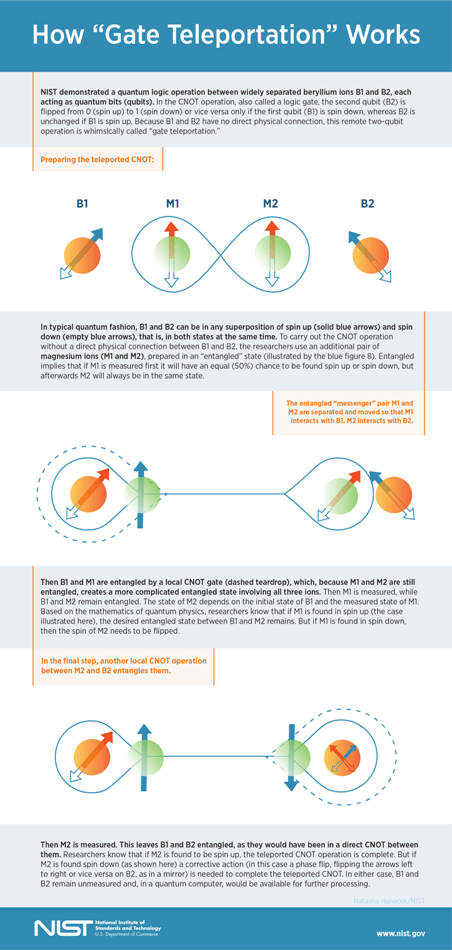May 31 2019
At the National Institute of Standards and Technology (NIST), physicists have successfully teleported a computer circuit instruction called a quantum logic operation between a pair of isolated ions, or electrically charged atoms, demonstrating how tasks can be performed by quantum computer programs in upcoming large-scale quantum networks.
 Infographic explaining how gate teleportation works. (Image credit: D. Leibfried, N. Hanacek/NIST)
Infographic explaining how gate teleportation works. (Image credit: D. Leibfried, N. Hanacek/NIST)
In quantum teleportation, data is transferred from one quantum system such as an ion to another quantum system, such as a second ion, even if both are fully separated from one another, similar to two books kept in the basements of individual buildings. This is a real-life form of teleportation, where it is not matter but quantum data that is transported. This is in contrast to the Star Trek version of “beaming” the entire human race from a spaceship to a planet, for example.
Teleportation of quantum information has been already shown with ions and a wide range of other kinds of quantum systems; however, in this latest study, ions were used for the first time to teleport an entire quantum logic operation. Ions are considered a leading candidate for designing next-generation quantum computers. The experiments have been detailed in the May 31st issue of Science.
We verified that our logic operation works on all input states of two quantum bits with 85 to 87% probability—far from perfect, but it is a start.
Dietrich Leibfried, Physicist, National Institute of Standards and Technology
If there is a scope to construct a full-scale quantum computer, then specific issues that are currently inflexible can possibly be solved. NIST has supported global research efforts to exploit quantum behavior for feasible technologies, including attempts to construct quantum computers.
If quantum computers have to perform as expected, then they may require an unlimited number of quantum bits (qubits) and also ways to perform operations between qubits that are distributed across large-scale networks and machines. One way to do that is to teleport logic operations without making direct quantum mechanical connections; however, physical connections will still be required for the exchange of standard data.
The NIST researchers successfully teleported a quantum controlled-NOT (CNOT) logic gate, or logic operation, between a couple of beryllium ion qubits placed over 340 µm (millionths of a meter) apart in individual zones of an ion trap—a distance that eliminates any significant direct interaction. Next a CNOT logic operation flips the second qubit from 1 to 0 or vice versa, provided the first qubit is always 1; however, nothing will happen if the first qubit is 0. In standard quantum fashion, both qubits can be in “superpositions” wherein they possess values of both 0 and 1 simultaneously.
The teleportation process developed by the NIST team depends on entanglement, which connects the particles’ quantum properties even when they are isolated. Information is transferred between the beryllium ions by using a “messenger” pair of entangled magnesium ions, as shown in the above image.
The NIST researchers discovered that both magnesium ions were entangled by their teleported CNOT process—an important early step—with a success rate of 95%, whereas the full logic operation succeeded 85% to 87% of the time.
Gate teleportation allows us to perform a quantum logic gate between two ions that are spatially separated and may have never interacted before. The trick is that they each have one ion of another entangled pair by their side, and this entanglement resource, distributed ahead of the gate, allows us to do a quantum trick that has no classical counterpart. The entangled messenger pairs could be produced in a dedicated part of the computer and shipped separately to qubits that need to be connected with a logic gate but are in remote locations.
Dietrich Leibfried, Physicist, National Institute of Standards and Technology
For the first time, the NIST study also incorporated a number of operations into a single experiment; these operations will be required for constructing large-scale quantum computers predicated on ions, including control of ion transport, varied types of ions, and entangling operations on certain subsets of the system.
In order to validate that they executed a CNOT gate, the investigators prepared the first qubit in 16 varied combinations of input states and subsequently determined the outputs on the second qubit. This resulted in a generalized quantum “truth table” indicating that the process certainly worked.
Apart from producing a truth table, the team checked the data consistency over long run times to help detect error sources in the experimental arrangement. It is hoped that this method may prove to be a major tool in the characterization of quantum information processes in upcoming experiments.
The Office of the Director of National Intelligence, the Intelligence Advanced Research Projects Activity, and the Office of Naval Research supported the study.